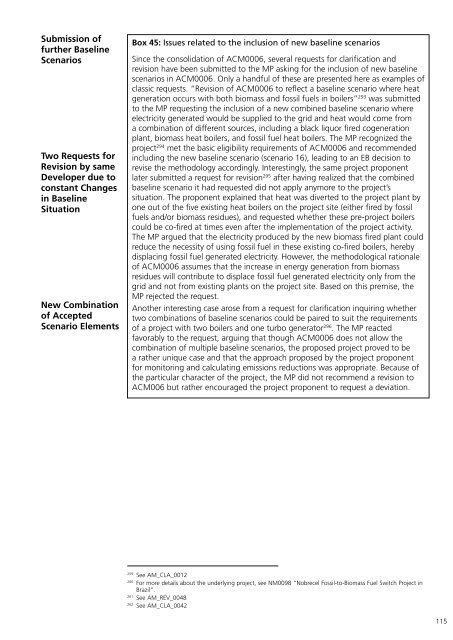Understanding CDM Methodologies - SuSanA
Understanding CDM Methodologies - SuSanA
Understanding CDM Methodologies - SuSanA
You also want an ePaper? Increase the reach of your titles
YUMPU automatically turns print PDFs into web optimized ePapers that Google loves.
Submission of<br />
further Baseline<br />
Scenarios<br />
Two Requests for<br />
Revision by same<br />
Developer due to<br />
constant Changes<br />
in Baseline<br />
Situation<br />
New Combination<br />
of Accepted<br />
Scenario Elements<br />
Box 45: Issues related to the inclusion of new baseline scenarios<br />
Since the consolidation of ACM0006, several requests for clarification and<br />
revision have been submitted to the MP asking for the inclusion of new baseline<br />
scenarios in ACM0006. Only a handful of these are presented here as examples of<br />
classic requests. “Revision of ACM0006 to reflect a baseline scenario where heat<br />
generation occurs with both biomass and fossil fuels in boilers” 293 was submitted<br />
to the MP requesting the inclusion of a new combined baseline scenario where<br />
electricity generated would be supplied to the grid and heat would come from<br />
a combination of different sources, including a black liquor fired cogeneration<br />
plant, biomass heat boilers, and fossil fuel heat boilers. The MP recognized the<br />
project 294 met the basic eligibility requirements of ACM0006 and recommended<br />
including the new baseline scenario (scenario 16), leading to an EB decision to<br />
revise the methodology accordingly. Interestingly, the same project proponent<br />
later submitted a request for revision 295 after having realized that the combined<br />
baseline scenario it had requested did not apply anymore to the project’s<br />
situation. The proponent explained that heat was diverted to the project plant by<br />
one out of the five existing heat boilers on the project site (either fired by fossil<br />
fuels and/or biomass residues), and requested whether these pre-project boilers<br />
could be co-fired at times even after the implementation of the project activity.<br />
The MP argued that the electricity produced by the new biomass fired plant could<br />
reduce the necessity of using fossil fuel in these existing co-fired boilers, hereby<br />
displacing fossil fuel generated electricity. However, the methodological rationale<br />
of ACM0006 assumes that the increase in energy generation from biomass<br />
residues will contribute to displace fossil fuel generated electricity only from the<br />
grid and not from existing plants on the project site. Based on this premise, the<br />
MP rejected the request.<br />
Another interesting case arose from a request for clarification inquiring whether<br />
two combinations of baseline scenarios could be paired to suit the requirements<br />
of a project with two boilers and one turbo generator 296 . The MP reacted<br />
favorably to the request, arguing that though ACM0006 does not allow the<br />
combination of multiple baseline scenarios, the proposed project proved to be<br />
a rather unique case and that the approach proposed by the project proponent<br />
for monitoring and calculating emissions reductions was appropriate. Because of<br />
the particular character of the project, the MP did not recommend a revision to<br />
ACM006 but rather encouraged the project proponent to request a deviation.<br />
259260261262<br />
259<br />
See AM_CLA_0012<br />
260<br />
For more details about the underlying project, see NM0098 “Nobrecel Fossil-to-Biomass Fuel Switch Project in<br />
Brazil”.<br />
261<br />
See AM_REV_0048<br />
262<br />
See AM_CLA_0042<br />
115

















